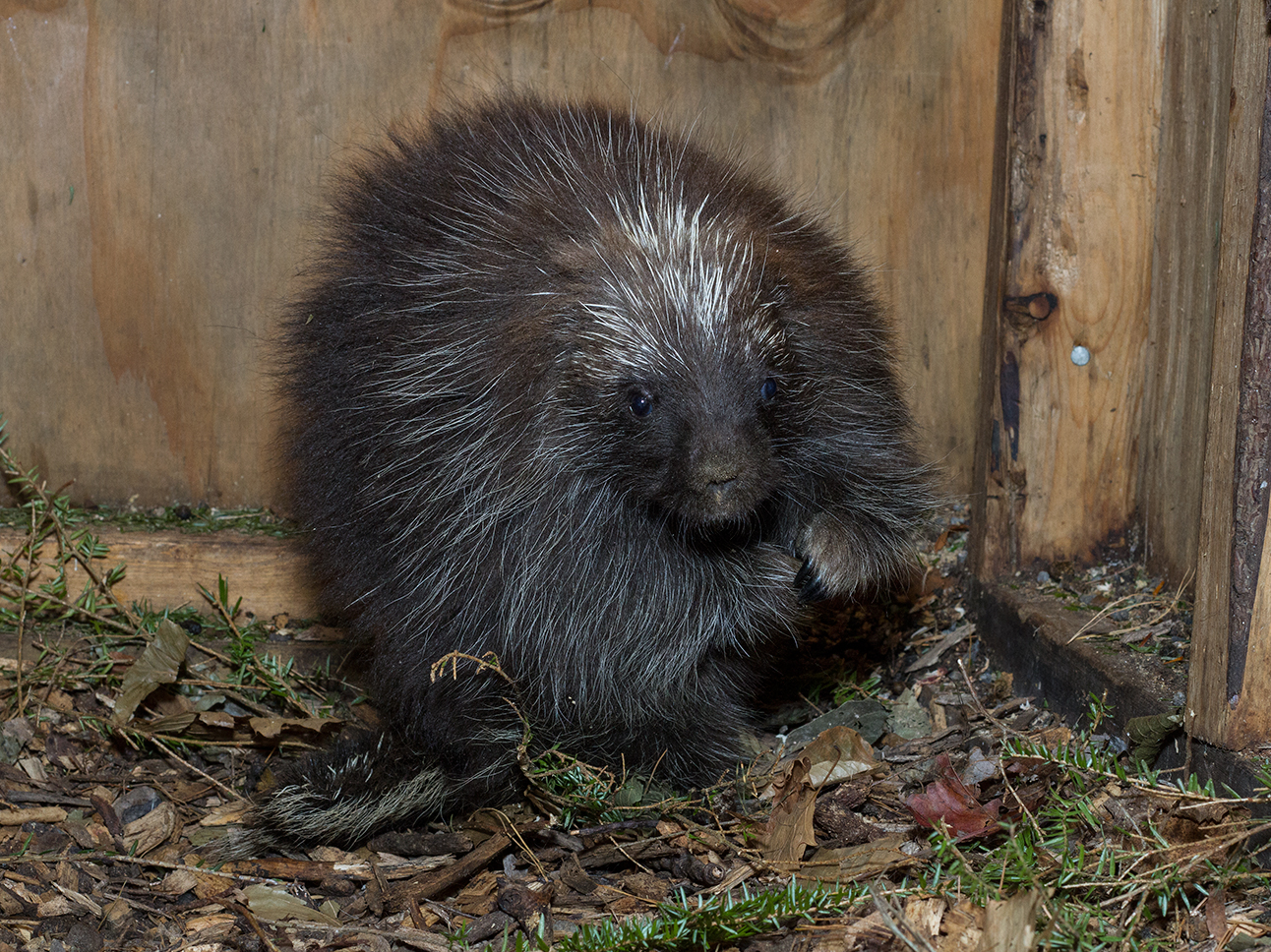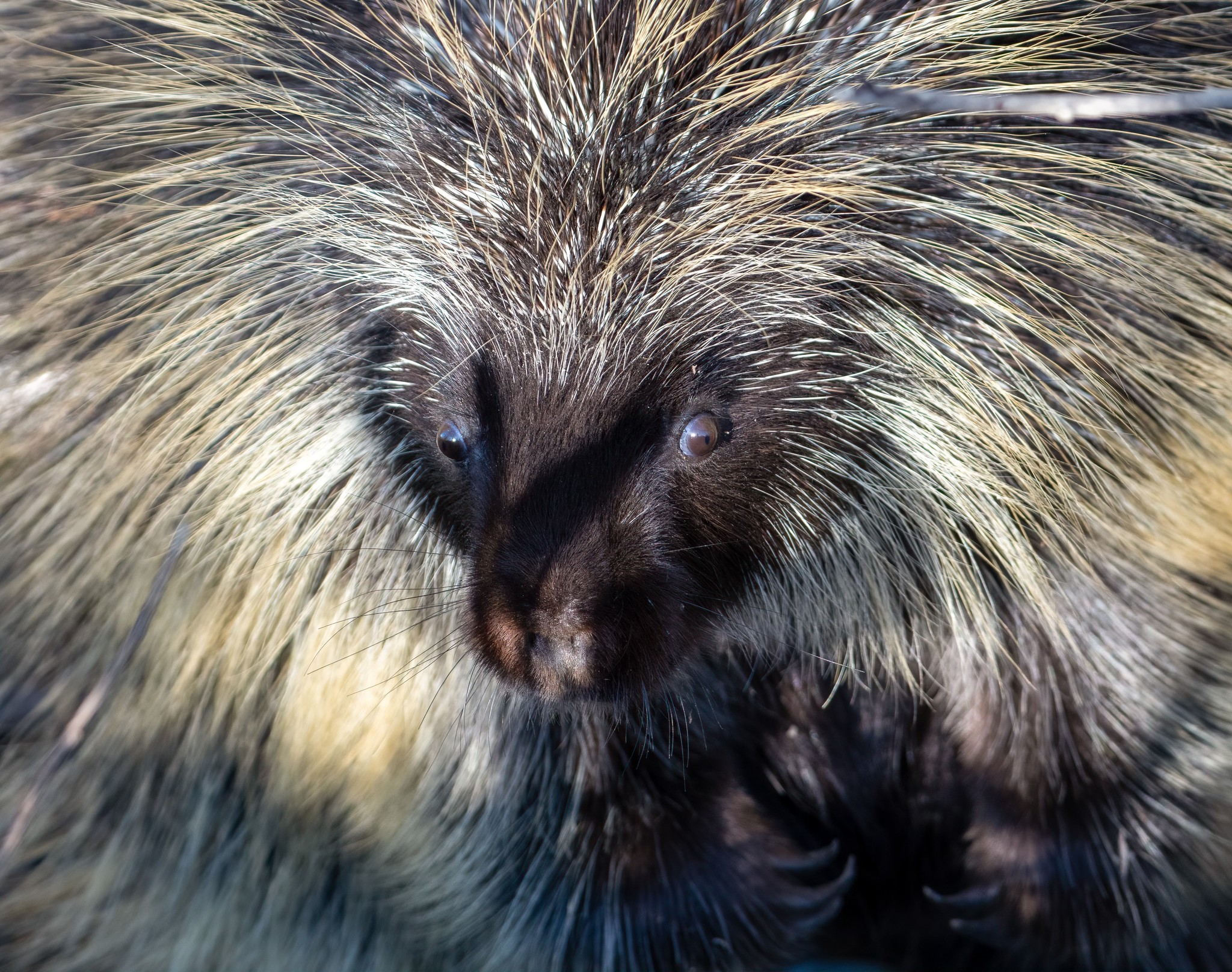|
Porcupine
Porcupines are large rodents with coats of sharp spines, or quills, that protect them against predation. The term covers two families of animals: the Old World porcupines of family Hystricidae, and the New World porcupines of family, Erethizontidae. Both families belong to the infraorder Hystricognathi within the profoundly diverse order Rodentia and display superficially similar coats of rigid or semi-rigid quills, which are modified hairs composed of keratin. Despite this, the two groups are distinct from one another and are not closely related to each other within the Hystricognathi. The largest species of porcupine is the third-largest living rodent in the world, after the capybara and beaver. The Old World porcupines (Hystricidae) live in Italy, Asia (western and southern), and most of Africa. They are large, terrestrial, and strictly nocturnal. The New World porcupines (Erethizontidae) are indigenous to North America and northern South America. They live in wooded ar ... [...More Info...] [...Related Items...] OR: [Wikipedia] [Google] [Baidu] |
North American Porcupine
The North American porcupine (''Erethizon dorsatum''), also known as the Canadian porcupine, is a large quill-covered rodent in the New World porcupine family. It is the second largest rodent in North America, after the North American beaver (''Castor canadensis''). The porcupine is a caviomorph rodent whose ancestors crossed the Atlantic from Africa to Brazil 30 million years ago, and then migrated to North America during the Great American Interchange after the Isthmus of Panama rose 3 million years ago. Etymology The word "porcupine" comes from the middle or old French word , which means 'thorn pig'. Its roots derive from the Latin words or pig and meaning thorns. Other colloquial names for the animal include quill pig. It is also referred to as the Canadian porcupine or common porcupine. The porcupine's scientific name, ''Erethizon dorsatum'', can be loosely translated as "the animal with the irritating back". Native American terms for it include the Lakota name meaning ... [...More Info...] [...Related Items...] OR: [Wikipedia] [Google] [Baidu] |
Old World Porcupine
The Old World porcupines, or Hystricidae, are large terrestrial rodents, distinguished by the spiny covering from which they take their name. They range over the south of Europe and the Levant, most of Africa, India, and Southeast Asia as far east as Flores. Although both the Old World and New World porcupine families belong to the infraorder Hystricognathi of the vast order Rodentia, they are quite different and are not particularly closely related. Characteristics Old World porcupines are stout, heavily built animals, with blunt, rounded heads, fleshy, mobile snouts, and coats of thick cylindrical or flattened spines, which form the whole covering of their bodies, and are not intermingled with ordinary hairs. The habits of most species are strictly terrestrial. They vary in size from the relatively small long–tailed porcupine with body lengths of , and a weight of , to the much larger crested porcupines, which are long, discounting the tail, and weigh from . The various ... [...More Info...] [...Related Items...] OR: [Wikipedia] [Google] [Baidu] |
New World Porcupine
The New World porcupines, family Erethizontidae, are large arboreal rodents, distinguished by their spiny coverings from which they take their name. They inhabit forests and wooded regions across North America, and into northern South America. Although both the New World and Old World porcupine families belong to the Hystricognathi branch of the vast order Rodentia, they are quite different and are not closely related. Characteristics New World porcupines are stout animals, with blunt, rounded heads, fleshy, mobile snouts, and coats of thick, cylindrical or flattened spines. The "quills" are mixed with long, soft hairs. They vary in size from the relatively small prehensile-tailed porcupines, which are around long, and weigh about , to the much larger North American porcupine, which has a body length of , and weighs up to . They are distinguished from the Old World porcupines in that they have rooted molars, complete collar bones, entire upper lips, tuberculated soles, no t ... [...More Info...] [...Related Items...] OR: [Wikipedia] [Google] [Baidu] |
Rodent
Rodents (from Latin , 'to gnaw') are mammals of the order Rodentia (), which are characterized by a single pair of continuously growing incisors in each of the upper and lower jaws. About 40% of all mammal species are rodents. They are native to all major land masses except for New Zealand, Antarctica, and several oceanic islands, though they have subsequently been introduced to most of these land masses by human activity. Rodents are extremely diverse in their ecology and lifestyles and can be found in almost every terrestrial habitat, including human-made environments. Species can be arboreal, fossorial (burrowing), saltatorial/richochetal (leaping on their hind legs), or semiaquatic. However, all rodents share several morphological features, including having only a single upper and lower pair of ever-growing incisors. Well-known rodents include mice, rats, squirrels, prairie dogs, porcupines, beavers, guinea pigs, and hamsters. Rabbits, hares, and pikas, wh ... [...More Info...] [...Related Items...] OR: [Wikipedia] [Google] [Baidu] |
Echimyidae
Echimyidae is the family of neotropical spiny rats and their fossil relatives. This is the most species-rich family of hystricognath rodents. It is probably also the most ecologically diverse, with members ranging from fully arboreal to terrestrial to fossorial to semiaquatic habits. They presently exist mainly in South America; three members of the family also range into Central America, and the hutias are found in the Greater Antilles in the Caribbean. Species of the extinct subfamily Heteropsomyinae formerly lived on Cuba, Hispaniola, and Puerto Rico in the Antilles, probably until the arrival of Europeans. Characteristics In general form, most spiny rats resemble rats, although they are more closely related to guinea pigs and chinchillas. Most species have stiff, pointed hairs, or spines, that presumably serve for protection from predators. Many echimyids can break off their tails when attacked. This action may confuse predators long enough for the spiny rat to ... [...More Info...] [...Related Items...] OR: [Wikipedia] [Google] [Baidu] |
Hystricognathi
The Hystricognathi are an infraorder of rodents, distinguished from other rodents by the bone structure of their skull The skull is a bone protective cavity for the brain. The skull is composed of four types of bone i.e., cranial bones, facial bones, ear ossicles and hyoid bone. However two parts are more prominent: the cranium and the mandible. In humans, th ...s. The masseter, masseter medialis (a jaw muscle) passes partially through a hole below each eye socket (called the infraorbital foramen) and connects to the bone on the opposite side. This, together with their lack of an infraorbital plate and the relative size of the infraorbital foramen, distinguishes hystricognaths from other rodent groups. The 18 family (biology), families within the Hystricognathi are divided into two parvorders, the Phiomorpha and the Caviomorpha. The Caviomorpha are mostly native to List of mammals of South America#Order: Rodentia (rodents), South America, with a few species in the List of r ... [...More Info...] [...Related Items...] OR: [Wikipedia] [Google] [Baidu] |
Diamantomyidae
Diamantomyidae is a family of extinct hystricognath rodents from Africa and Asia Asia (, ) is one of the world's most notable geographical regions, which is either considered a continent in its own right or a subcontinent of Eurasia, which shares the continental landmass of Afro-Eurasia with Africa. Asia covers an area .... References Hystricognath rodents Prehistoric rodent families Eocene first appearances Miocene first appearances {{paleo-rodent-stub ... [...More Info...] [...Related Items...] OR: [Wikipedia] [Google] [Baidu] |
Octodontidae
Octodontidae is a family of rodents, restricted to southwestern South America. Fourteen species of octodontid are recognised, arranged in seven genera. The best known species is the common degu, ''Octodon degus''. Octodontids are medium-sized rodents, ranging from in body length. They have long, silky, fur, which is typically brownish in color, and often paler on the underside. The name 'octodont' derives from the wear pattern of their teeth, which resembles a figure 8. Most are nocturnal, social, burrowing animals, though the degu is largely diurnal. They are herbivorous, eating tubers, bulbs, and cactuses. Some authors have suggested that the octodontids should be reclassified in the order Lagomorpha, but this has not been supported by further analyses. Older literature includes the tuco-tucos in the family, as the subfamily Ctenomyinae, but these animals are normally now treated as a separate family, Ctenomyidae. There is some evidence that evolution within the family may ... [...More Info...] [...Related Items...] OR: [Wikipedia] [Google] [Baidu] |
Bathyergoididae
''Bathyergoides'' is an extinct genus of rodent from Africa thought to be related to the modern blesmols. It is the only member of the family Bathyergoididae. Fossils of ''Bathyergoides neotertiarius'' were recovered from the Early Miocene Elisabeth Bay Formation of Namibia Namibia (, ), officially the Republic of Namibia, is a country in Southern Africa. Its western border is the Atlantic Ocean. It shares land borders with Zambia and Angola to the north, Botswana to the east and South Africa to the south and ea ....Pickford, 2018, p.88 References Bibliography * Hystricognath rodents Prehistoric rodent genera Miocene rodents Miocene mammals of Africa Fossils of Namibia Fossil taxa described in 1923 Taxa named by Ernst Stromer {{paleo-rodent-stub ... [...More Info...] [...Related Items...] OR: [Wikipedia] [Google] [Baidu] |
Family (biology)
Family ( la, familia, plural ') is one of the eight major hierarchical taxonomic ranks in Linnaean taxonomy. It is classified between order and genus. A family may be divided into subfamilies, which are intermediate ranks between the ranks of family and genus. The official family names are Latin in origin; however, popular names are often used: for example, walnut trees and hickory trees belong to the family Juglandaceae, but that family is commonly referred to as the "walnut family". What belongs to a family—or if a described family should be recognized at all—are proposed and determined by practicing taxonomists. There are no hard rules for describing or recognizing a family, but in plants, they can be characterized on the basis of both vegetative and reproductive features of plant species. Taxonomists often take different positions about descriptions, and there may be no broad consensus across the scientific community for some time. The publishing of new data and opi ... [...More Info...] [...Related Items...] OR: [Wikipedia] [Google] [Baidu] |
Predation
Predation is a biological interaction where one organism, the predator, kills and eats another organism, its prey. It is one of a family of common feeding behaviours that includes parasitism and micropredation (which usually do not kill the host) and parasitoidism (which always does, eventually). It is distinct from scavenging on dead prey, though many predators also scavenge; it overlaps with herbivory, as seed predators and destructive frugivores are predators. Predators may actively search for or pursue prey or wait for it, often concealed. When prey is detected, the predator assesses whether to attack it. This may involve ambush or pursuit predation, sometimes after stalking the prey. If the attack is successful, the predator kills the prey, removes any inedible parts like the shell or spines, and eats it. Predators are adapted and often highly specialized for hunting, with acute senses such as vision, hearing, or smell. Many predatory animals, both vertebr ... [...More Info...] [...Related Items...] OR: [Wikipedia] [Google] [Baidu] |





_with_its_prey.jpg)